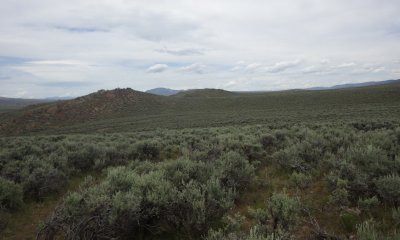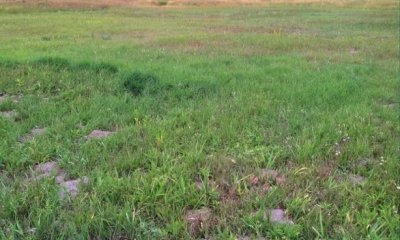
Loamy Calcareous Bear River Valley 10-14" P.Z.
Circle-spoke model
Scenario model
Current land use
Select a land use
Management practices/drivers
Select a conversion
-
Conversion C1A
Flood irrigation, tillage, and seeding
More details -
Conversion C1B
Irrigation (improved flood or sprinkler), tillage, and seeding
More details -
Conversion C2A
Sprinkler irrigation, tillage, and seeding
More details -
No conversion pathway between the selected land uses has been described
Target land use
Select a land use
Description
Rangeland is the dominant land use for this site and provides the most diverse ecosystem services. Range is land on which the historic and introduced vegetation is predominantly grasses, grass-like plants, forbs or shrubs managed as a natural ecosystem. Range may include natural grasslands, savannas, shrublands, tundra, alpine communities, marshes and meadows.
Characteristics and indicators
This land use consists of diverse native plant communities dominated by big sagebrush and perennial cool season grasses that provide for site stability, hydrologic function, and biotic integrity of the site.
Submodel
Description
This is a moderately deep to deep site with very few limitations for agriculture production, and therefore is often converted to irrigated pasture due to high water holding capacity, low slopes, and landscape position that lends itself to tillage and irrigation practices. The site is also converted to dryland pasture to a lesser extent.
Pastureland is land composed of introduced or domesticated native forage species that is used primarily for the production of livestock. Pastures receive periodic renovation and cultural treatments, such as tillage, fertilization, mowing, weed control, and may be irrigated. Pastures are not in rotation with crops.
Characteristics and indicators
Pasture on this site can be either dryland or irrigated.
Irrigated pasture was often historically tilled and irrigation infrastructure installed. Perennial forage species such as Kentucky bluegrass, smooth brome, and white or alsike clover were often seeded historically. In more recent times, creeping meadow foxtail was introduced to the Bear River Valley, and has taken over many flood irrigated pastures. Irrigated pasture is maintained through irrigation, dragging, grazing and occasional haying practices. Hay production with aftermath grazing is common, but pastures on this site can also be managed for grazing throughout the growing season with some dormant season grazing as well.
Dryland pasture was often historically tilled and planted to crested wheatgrass and has maintained itself over time with minimal inputs such as mowing, disking, dragging, or harrowing. Occasional haying on dryland pasture typically occurs only in the wettest years.
Submodel
Description
This is a moderately deep to deep site with very few limitations for agriculture production, and therefore is often converted to irrigated crop due to high water holding capacity, low slopes, and landscape position that lends itself to tillage and irrigation practices.
Cropland is land used primarily for the production and harvest of an annual or perennial field, forage, food, fiber, horticultural, orchard, vineyard, or energy crops.
Characteristics and indicators
Crop on this site is typically irrigated.
Irrigated crop on this site is typically perennial and consists of a mixture of legume (alfalfa or clover) and a variety of cool-season perennial forage grasses in rotation with short-season annual cereal grains such as barley. The annual portion of the crop rotation is often grown as a forage (not cash) crop.
Submodel
Mechanism
Most range conversion to pasture occurred at the end of the 19th century and was done using horse-pulled implements and hand tools. Flood irrigation infrastructure was installed and introduced species seeded such as Kentucky bluegrass and clover. Wild flood irrigation is the most common with little control and sometimes water is checked at the bottom of fields to backup water and promote extended flooded condtions that result in more hydrophytic vegetation and hydric soil development.
Mechanism
Most range conversion to crop occurred at the end of the 19th century and was done using horse-pulled implements and hand tools. Flood irrigation infrastructure such as graded borders were installed and introduced species seeded such as smooth brome and alfalfa in rotation with annual cereal grains such as oats and barley. The water source is surface water from the Bear River.
In recent times there have been some range conversion to crop using sprinkler irrigation to improve water efficiency and control plus reduce labor. Higher value forage grasses such as meadow brome and non-bloat legumes such as sainfoin and cicer milkvetch have also been introduced into the crop rotation.
Model keys
Briefcase
Add ecological sites and Major Land Resource Areas to your briefcase by clicking on the briefcase (![]() ) icon wherever it occurs. Drag and drop items to reorder. Cookies are used to store briefcase items between browsing sessions. Because of this, the number of items that can be added to your briefcase is limited, and briefcase items added on one device and browser cannot be accessed from another device or browser. Users who do not wish to place cookies on their devices should not use the briefcase tool. Briefcase cookies serve no other purpose than described here and are deleted whenever browsing history is cleared.
) icon wherever it occurs. Drag and drop items to reorder. Cookies are used to store briefcase items between browsing sessions. Because of this, the number of items that can be added to your briefcase is limited, and briefcase items added on one device and browser cannot be accessed from another device or browser. Users who do not wish to place cookies on their devices should not use the briefcase tool. Briefcase cookies serve no other purpose than described here and are deleted whenever browsing history is cleared.
Ecological sites
Major Land Resource Areas
The Ecosystem Dynamics Interpretive Tool is an information system framework developed by the USDA-ARS Jornada Experimental Range, USDA Natural Resources Conservation Service, and New Mexico State University.


